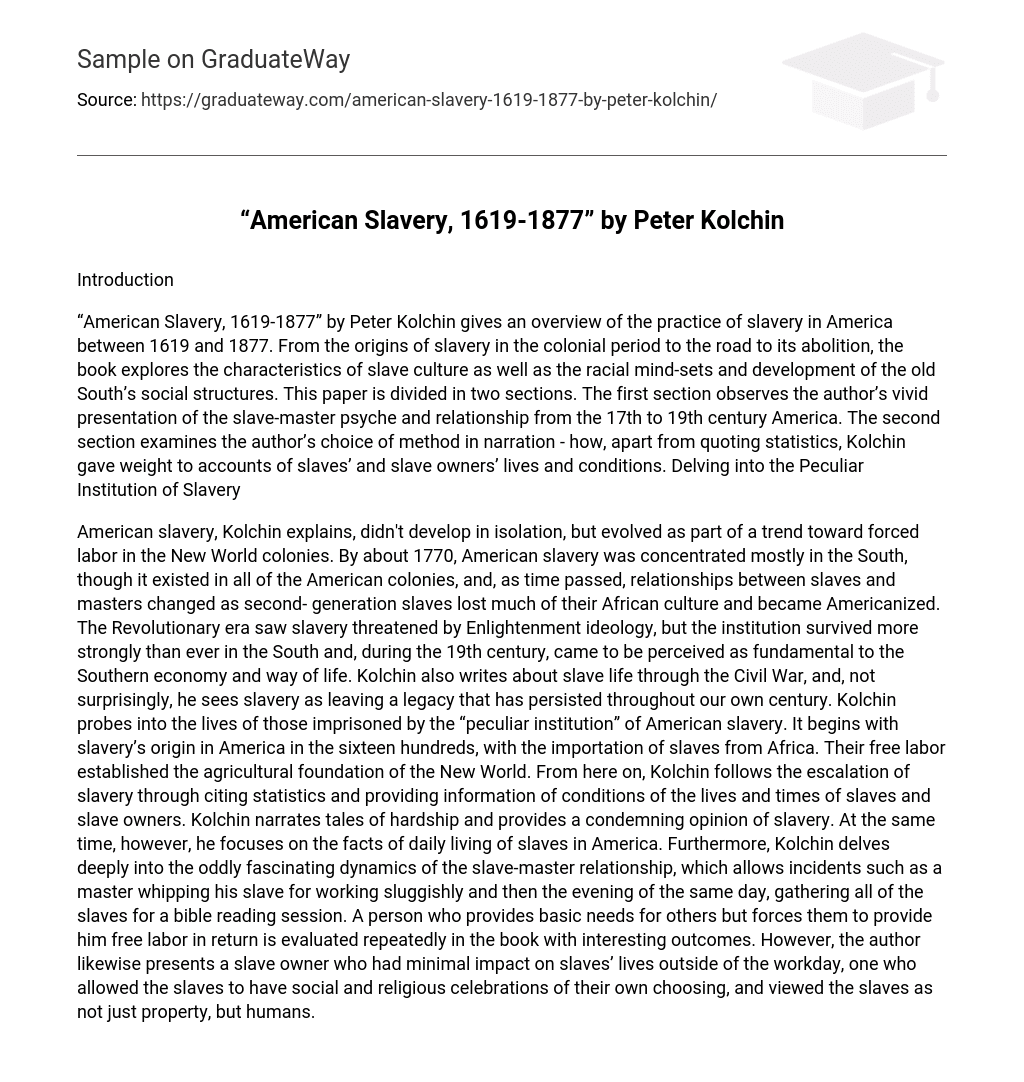Introduction
“American Slavery, 1619-1877” by Peter Kolchin gives an overview of the practice of slavery in America between 1619 and 1877. From the origins of slavery in the colonial period to the road to its abolition, the book explores the characteristics of slave culture as well as the racial mind-sets and development of the old South’s social structures. This paper is divided in two sections. The first section observes the author’s vivid presentation of the slave-master psyche and relationship from the 17th to 19th century America. The second section examines the author’s choice of method in narration – how, apart from quoting statistics, Kolchin gave weight to accounts of slaves’ and slave owners’ lives and conditions. Delving into the Peculiar Institution of Slavery
American slavery, Kolchin explains, didn’t develop in isolation, but evolved as part of a trend toward forced labor in the New World colonies. By about 1770, American slavery was concentrated mostly in the South, though it existed in all of the American colonies, and, as time passed, relationships between slaves and masters changed as second- generation slaves lost much of their African culture and became Americanized. The Revolutionary era saw slavery threatened by Enlightenment ideology, but the institution survived more strongly than ever in the South and, during the 19th century, came to be perceived as fundamental to the Southern economy and way of life. Kolchin also writes about slave life through the Civil War, and, not surprisingly, he sees slavery as leaving a legacy that has persisted throughout our own century. Kolchin probes into the lives of those imprisoned by the “peculiar institution” of American slavery. It begins with slavery’s origin in America in the sixteen hundreds, with the importation of slaves from Africa. Their free labor established the agricultural foundation of the New World. From here on, Kolchin follows the escalation of slavery through citing statistics and providing information of conditions of the lives and times of slaves and slave owners. Kolchin narrates tales of hardship and provides a condemning opinion of slavery. At the same time, however, he focuses on the facts of daily living of slaves in America. Furthermore, Kolchin delves deeply into the oddly fascinating dynamics of the slave-master relationship, which allows incidents such as a master whipping his slave for working sluggishly and then the evening of the same day, gathering all of the slaves for a bible reading session. A person who provides basic needs for others but forces them to provide him free labor in return is evaluated repeatedly in the book with interesting outcomes. However, the author likewise presents a slave owner who had minimal impact on slaves’ lives outside of the workday, one who allowed the slaves to have social and religious celebrations of their own choosing, and viewed the slaves as not just property, but humans.
The irony of this is that slave owners saw no wrong in what they were doing, regardless of how they treated their respective slaves. Slavery, as an institution, was from the perspective of the slave owners, justified. Kolchin describes that, in response, slaves were overtly resistive to their predicament at times, while others provided less obvious resistance in the form of slow work, feigning illness, and even sabotage. In addition, Kolchin gives the readers the catalysts for the events in the history of slavery. Economic, religious, and social factors are made prevalent, which renders the book well organized and able to reach depths that a few other books with the same topic failed to achieve. Even though the war ended, hatred for blacks remains. Thus, segregation evolves in full force throughout the nation, but mainly in the south. He also explains the struggle of the south to compete with the north as far as industrialization which was the new course of America straying away from agriculture, and until today they still suffer a lack of industry opposed to the northern states.
Method of Narration
The book’s chronological format of the book provides a logical flow and allows the reader to see the manner by which the events of each day made tremendous impact on slavery. The bibliographical essay lists hundreds of books that pertain to the writing in a sectional format and describes particular topics covered in each book. This is easy to see in the straightforward and matter-of-fact way that the author discusses topics from whipping of slaves, to the selling of slaves resulting in the breakup of families. Kolchin effectively used statistics in writing this book, in that, at the start of most sections or chapters the reader was able to ascertain the slave population and distribution, as well as growth rates and comparison to white population. Kolchin’s interpretation of this particular historic era shows that its’ history is primarily determined by individuals with economic motivations. When the author wanted to explain the horrors of these situations, he used quotes from slaves themselves, not a personal soapbox that many authors use. By using these comparisons the reader can see how the treatment of slaves was paramount to production, controllability, and even reproduction. Conclusion
Peter Kolchin’s “American Slavery, 1619 – 1877,” provides a laudable and significant consideration of slavery in the formation of the United States as a country. It is a clear and briskly written survey that puts slavery in context and explains its continuing impact on American life. Overall, Kolchin displays an excellent work of literature which provides many sources and well-thought-out information.
Reference
Kolchin, Peter (1993). American Slavery, 1619-1877. Hill and Wang: New York.





